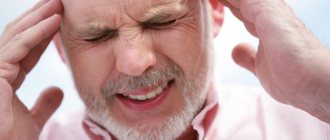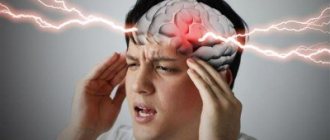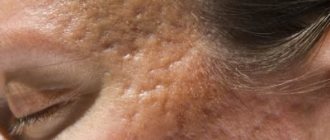Erythrophobia (synonyms: ereutophobia) is an anxious state of a person due to the fear of facial redness (synonyms: blushing, blushing syndrome, stress facial redness, stress facial hyperemia, stress facial erythema).
Phobia is fear, a complex of mental symptoms characteristic of the manifestation of uncontrollable fear, characterized by a stable mental experience, excessive anxiety in specific situations or in anticipation. Phobias are always irrational in nature - a person who is not susceptible to a phobia does not have similar logical reasons for fear. The antipode of phobia is philia. The phenomenon causes attraction, too strong an attraction to something.
In itself, redness of the face is not a pathological deviation - it is a reactive reflex phenomenon in response to acute stressful situations of embarrassment, fear, excitement, which are a protective reaction of the body. However, an exaggerated feeling of fear, as a result of such a reaction of the body, is a psychopathological condition, which is explained by the possible negative response of others - redness of the face can be interpreted by them as fear, awkwardness or insincerity. Women are especially susceptible to erythrophobia due to fear of loss of external attractiveness and sexuality.
Reasons for development
Overly shy people can often “blush”
In general, embarrassment and a blush on the cheeks do not cause rejection or ridicule among others, but people with erythrophobia do not think so. The tendency to flush the face in a stressful situation is due to physiological characteristics, namely the superficial location of the capillaries. At times of stress, blood literally rushes to the cheeks, and since the capillaries are located shallow under the skin, the redness of the face is noticeable to others. This is also accompanied by a feeling of heat in the face, so a person with this feature knows exactly when he starts to blush.
Despite the fact that the mechanism of facial redness during stress has been well studied, the causes of erythrophobia remain a mystery to psychologists and psychiatrists. This phobia has no clearly defined cause and is most likely caused by subjective feelings that arise during moments of stress or shame.
Many people associate erythrophobia with:
- features of the functioning of the nervous system;
- specifics of education;
- hidden complexes;
- features of behavior.
In general, the mechanism of facial redness is explained by the specifics of the nervous system, or more precisely, its autonomic department. For some reason, in moments of stress, it signals the blood vessels and capillaries to dilate. They fill with blood, a feeling of heat occurs, and the skin turns red. In people with closely spaced capillaries and thin skin, this is explained by physiological characteristics, but also in people with normal skin thickness, this phenomenon often occurs. However, the ability to blush in awkward situations does not mean the presence of erythrophobia. Some psychiatrists and psychotherapists believe that the appearance of a feeling of fear in response to a reaction from one’s own skin is explained by a surge in norepinephrine at times of stress. Thus, only people who do not know how to independently cope with the destructive influence of stress encounter a phobia, which means their nervous system is constantly under tension.
Another suspected reason for the appearance of a phobia is a peculiarity of upbringing. All children tend to play pranks and disobey their parents, but shy and modest children often take comments too seriously. For example, a child may do something bad, but does not admit it to his parents. Adults can easily guess about his offense, noticing that the blood rushes to the face and the baby experiences severe embarrassment and shame. If at this moment the parents put too much emphasis on the educational process (scold, punish the baby), an incorrect subconscious attitude may be formed that associates the process of blushing with the fear of punishment.
Erythrophobia may be a consequence of an inferiority complex and pathological feelings of guilt. A person constantly feels guilty for any of his actions and subconsciously expects criticism and punishment, while reddening of the skin of the face is taken as an admission of his misdeeds, thereby beginning to be afraid of this natural phenomenon.
Another reason may be a person’s hidden motives when committing an act. In this case, we are talking more about false erythrophobia, since the person does not experience fear of redness of the face, but fear of being discovered.
Erythrophobia from embarrassment. How to fight?
Erythrophobia, or the fear of being red, develops in people susceptible to blushing syndrome, that is, redness of the face. The reasons for the development of blushing syndrome can be both psychological and physical problems, for example, menopause. Blushing syndrome is sometimes equated to erythrophobia. This is not entirely correct, since not all people who are subject to excessive facial redness are ashamed of it and are afraid to blush.
The most difficult experience of facial redness is for people whose redness is caused by embarrassment. It is modest people with blushing syndrome who are susceptible to developing severe erythrophobia. After all, they are already afraid and embarrassed by those around them, and then there is this nuisance - a face covered in paint. How to be?
The following algorithm of actions helps many shy erythrophobics.
As a rule, the signal for blushing in shy people with blushing syndrome is an awkward question, in their opinion, that they were asked, or awkward silence.
Avoiding awkwardness in such a situation is very simple - you just need to raise your visor and honestly admit that you are embarrassed. The fact is that most people with various phobias suffer not only from their phobia itself, but also from the fear that it will become noticeable to others. Among people who already know about the phobia, fear decreases.
This is also true for erythrophobics. When a person with blushing syndrome is afraid of blushing, they are mainly afraid of being noticed for their embarrassment. Don't be afraid. Just at that moment when you feel that you are blushing from an awkward question, you need to honestly and quickly say, “You embarrassed me, I even blushed.” As soon as you say this, you will get rid of 50% of your fear, your fear will begin to decrease, and your skin will begin to turn pale. The person who asked the question that confused you will not notice anything at all, simply because he is not aimed at noticing anything.
Symptoms of erythrophobia
Increased heart rate appears
A symptom of erythrophobia is facial flushing in response to any psycho-emotional experiences, even minor ones. A person feels a rush of blood to the face and begins to experience anxiety and restlessness, as the redness is noticeable to others. Over time, these emotions deplete the nervous system, and a person begins to experience fear even in a calm state, constantly waiting for something to throw him off balance and red spots to appear on his face.
Anxiety and fear are associated not so much with the fact of redness of the skin, but with the emotions that precede this moment.
Some patients describe their experience as a constant agonizing wait for the moment the face turns red, that is, fear appears long before this happens.
In severe forms of erythrophobia, during a rush of blood to the skin of the face, a person faces a real panic attack. Its symptoms:
- growing anxiety;
- feeling of panic and uncontrollable fear;
- trembling hands;
- flushed face;
- chills and cold sweat;
- lack of air and shortness of breath;
- tachycardia;
- headache and dizziness;
- feeling of derealization.
It is interesting that a panic attack occurs in response to a feeling of fear at the moment of redness of the face, but at the same time it provokes dilation of the skin capillaries and a rush of blood, as it is accompanied by hyperactivity of the autonomic nervous system. In other words, a panic attack with erythrophobia makes the object of fear even more pronounced. In some cases, a person may experience such internal tension at this moment that the central nervous system simply cannot stand it, so a panic attack ends in a short-term fainting.
Etiology
The human face is an area of active blood circulation. To understand the process of redness appearing on the face, it is worth familiarizing yourself with the structure of the face.
Here are the muscles that penetrate the skin and are responsible for facial functions. In them and in the subcutaneous tissue there is an extensive vascular network, which consists of a large number of small vessels. Subcutaneous tissue contains a small amount of interstitial fluid, which helps reduce redness during vasodilation. The rush of blood is influenced by various reasons.
Erythrophobia occurs under the pressure of the following factors:
- disruptions or excessive activity of the somatic and autonomic nervous system;
- release of adrenaline into the circulatory system;
- improper upbringing, when a child does not receive enough attention and encouragement from parents;
- in stressful situations, if a person is trying to hide, hide, steal or commit an action that is contrary to moral rules.
In healthy people, severe facial hyperemia is associated with strong emotions, intense training and heavy physical exertion. It is observed as a reaction to changes in temperature (when it is too hot or cold).
A sick person may experience redness when there is the slightest sign of emotional arousal, which over time is perceived negatively by the individual, causing isolation, unsociability and fear. In this case, you can get rid of erythrophobia only after contacting specialists and undergoing a course of therapy.
How to treat erythrophobia?
For erythrophobia, treatment begins with a consultation with a general practitioner (therapist). The fact is that a rush of blood to the skin of the face can be a consequence of an overactive thyroid gland or high blood pressure, so you must first undergo a comprehensive examination to rule out organic causes of the phobia.
Then the patient needs to consult with a psychotherapist. The doctor will select the optimal treatment regimen based on the causes of erythrophobia and the severity of symptoms.
Psychotherapy
The task of the psychotherapist is to explain to the patient that redness of the facial skin in itself in response to strong emotions is not a pathology and is not dangerous to health. As a rule, cognitive-behavioral therapy is practiced, during which the patient must change his attitude towards blushing syndrome (this is the name for the phenomenon of stress-induced redness of the face).
An important part of therapy is restoring the patient’s adequate self-esteem and getting rid of feelings of guilt.
As a rule, hypnosis or Gestalt therapy for erythrophobia are ineffective and therefore are not used. During cognitive behavioral psychotherapy, it is possible to reduce the depth of the patient’s feelings due to facial redness, but a long course of treatment is required to completely get rid of the problem.
Methods that help get rid of blushing
- The first way is to relax the facial muscles. As soon as you feel that the tide is coming, try to relax the muscles of your neck and shoulders. A smile is the best way to hide your shortcomings. When smiling, almost all people's cheeks turn red.
- Blink and take a couple of deep breaths, focusing on your breathing. Practice this method at home, then it will become easier for you to say no to phobias and fears in public. Accept yourself as you are. Keep a cool mind in any situation.
- Do not wear clothes that restrict movement or cause excessive sweating.
- Expand your horizons and vocabulary, try to be less nervous. Many of us are afraid of blushing when we have nothing to say in response to our interlocutor. During stress during a conversation, many people begin to forget the right words, and then awkwardness arises.
Symptoms
Many people feel uncomfortable when their personal space is violated. Every person has a comfort zone, penetration into which makes them nervous and worry about their safety. When a person wants to be alone, but is unable to be alone with himself, a deterioration in mood and even health may occur. These features are normal, but sometimes they can indicate developing anthropophobia.
The main symptom of anthropophobia is compulsive behavior. It consists of performing obsessive actions or movements. The purpose of this behavior is to protect oneself from phobias and block inappropriate manifestations of fear. An example of compulsion is incessant counting in a stressful situation. For example, a person, finding himself in a crowd, without stopping, counts passers-by.
This disease entails the occurrence of many unpleasant conditions. Various neuroses, mental disorders, and depression accompany the already difficult life of a patient with anthropophobia. He is afraid that a stranger will attack him or infect him with an incurable disease. The feeling of loss of health during social contacts is another of the main symptoms of anthropophobia.
We suggest you read: Is the human papillomavirus transmitted to men?
His contacts are as limited as possible. He seeks to nullify communication even with the closest people. An anthropophobe will not ask for help and will most likely reject it if absolutely necessary.
Fear of people impairs a person's cognitive abilities. A subject who is overwhelmed by social anxiety has difficulty concentrating and is unable to absorb new information. He loses the ability to learn and develop. In parallel with problems with concentration, an anthropophobe has difficulties remembering and retrieving information.
It is not easy for someone suffering from such a phobia to find a job, because most professions involve communication. And any training requires communication, which is impossible, because the fear of people is stronger than the desire to work.
Traditional medicine recipes
Any treatment for facial redness in a folk recipe comes down to the use of external remedies in the form of compresses or lotions, as well as rubbing and taking soothing tinctures:
- You need to take 2 dessert spoons of burnet root, pour a glass of boiling water over them and leave for about half an hour. Use as a means for warm compresses, each of which should be kept on the face for no more than an hour.
- Grind oak bark, take one spoon of raw material and add it to 500 ml of water. Boil everything together for 10 minutes over moderate heat and then apply as compresses.
- Oak bark can be replaced with freshly brewed and strong infusion of high-quality black tea.
- In the morning, you need to completely wipe your body with cool water with the addition of table salt. For 1 liter of water – 1 teaspoon of crystals.
- You should regularly take a contrast shower, which will allow the skin to adapt to temperature changes and stop reacting with redness to changing climatic conditions.
- A decoction made from the green parts of peppermint is used to rinse the body before going to bed. 1 dessert spoon of fresh mint leaves is brewed with a glass of boiling water, infused for 15 minutes and the entire volume is diluted in 5 liters of warm water prepared for washing.
- It is recommended to drink mint tea as a natural sedative: half a cup twice a day.
Treatment at home
Among the non-traditional means, the following methods can be distinguished:
1. Mint decoction. You need to chop 1 tablespoon of mint leaves and pour a glass of boiling water over it. The resulting composition is kept in a water bath for 15 minutes, and then cooled and drunk half a glass in the morning and evening. 2. Hardening. It is necessary to douse yourself with cool water every morning, gradually lowering its temperature. In the evening a contrast shower is shown. 3. Yoga, breathing exercises. These methods will increase self-confidence and reduce unwanted heartbeat.
It is necessary to exclude massage, hot baths and compresses.
Fear of blushing leads to a deterioration in the quality of life and the development of depression. Therefore, it is necessary to treat it completely using modern methods of therapy. It is worth contacting a psychotherapist who will help you find the essence of the problem and relieve unpleasant symptoms.
Diagnostics
The diagnosis is made by a psychologist or psychotherapist based on complaints and examination results. Erythrophobia in blushing syndrome is differentiated from facial redness during menopause, the initial stage of rosacea, carcinoid syndrome and facial hyperemia when taking certain medications. To exclude the listed diseases and conditions, patients suffering from erythrophobia are referred for consultation to a gynecologist, endocrinologist, oncologist and dermatologist. The list of additional studies for erythrophobia is determined individually depending on the existing symptoms.
Treatment
Treatment of erythrophobia is aimed at reducing symptomatic manifestations, increasing self-esteem, reducing the excitability of the nervous system, or radically removing the problem.
Therapy may include the following:
- psychotherapy sessions - hypnosis and cognitive behavioral therapy;
- relaxation technique - self-hypnosis, training in special breathing techniques with muscle relaxation;
- drug treatment - beta blockers (to reduce the heart rate, interrupting the relationship between the emotional background and facial hyperemia) and antidepressants (help reduce fear, anxiety and worry), however, it is worth knowing about a large list of contraindications and adverse reactions;
- surgery is the most effective method.
Surgery for erythrophobia is called sympathectomy. Surgical intervention gives good results: in 90% of cases of classic hyperemia, which spreads to the entire surface of the face, there is a significant improvement or complete recovery. If the patient has redness in isolated areas, the success of surgical intervention is 50%.
Surgical procedures are contraindicated if the patient has concomitant diseases:
- pleurisy;
- emphysema;
- tuberculosis;
- severe respiratory or cardiovascular failure.
During the operation, the patient's sympathetic trunk, which affects reactions in the upper part of the body, is completely blocked or destroyed. Endoscopic equipment is used. The surgeon makes two incisions in the armpits and inserts a camera, which facilitates the use of the technique.
The sympathetic nerve is exposed to electric current or clipped (the method is reversible). The reversibility of the operation will help get rid of complications, since not everyone experiences the intervention without consequences.
Operating on blush
I probably would have come to terms with my misfortune if it weren’t for meeting Karl. A young historian came to Russia from Munich and collected materials from our archives for his book about the Second World War. I helped him find the necessary documents. Suddenly, working together became friendship, and then turned into more serious feelings. Now I understand that my courage in this relationship at that time was explained by the use of strong drugs. Inspired, literally pumped up with pills, I went to visit Karl in Germany.
And then I noticed that my recent salvation—medicines—was no longer working. A completely unfamiliar environment, the need to communicate in a foreign language with Karl’s friends and relatives... Every look made me blush.
At first Karl laughed it off: I have such a ruddy Russian girl, very shy... And then my endless panic attacks began to irritate him too. Soon I bought a return ticket to Moscow. Literally on the day of departure, Karl’s father (he practiced as a homeopath in one of the Munich clinics) called me aside and said that in Germany there is a doctor, Christoph Schick, who ... operates on my illness.
To be honest, at first I thought that I had translated it incorrectly from German. How can you treat blush? Having returned to Moscow, I surfed the Internet and discovered that blushing has indeed recently been treated with surgery. There are also surgeons in Russia who have mastered this technique.
Work on yourself
There are many psychological trainings that help increase self-esteem. In the presence of erythrophobia, the person who blushes is afraid of being ridiculed by others. Remember that it is not your fault, it is your physiological feature.
Learn not to look away and try to keep your interlocutor at a comfortable distance. Take control of the situation. If you can’t work on your self-esteem on your own, use the help of a psychologist. You need to realize why a wave of embarrassment comes over you during a conversation. Understand your deepest fears and worries.
Sedatives from the pharmacy
Don't worry too much about what others might think of you.
Operation
Treatment of erythrophobia involves surgery.
During the operation, the operation of the nodes of one of the parts of the autonomic nervous system is affected. It's called sympathectomy .
It is used in case of lack of effect from psychotherapy and medications. For geographic erythrophobia, this method is not recommended.
There are other contraindications:
• serious damage to the heart and blood vessels; • severe sclerosis of cerebral vessels; • some infections.
Surgery is performed under general anesthesia.
It has side effects:
• hypotension; • increased sweating; • reduced reaction to stress.
Reviews about the operation are predominantly positive. Many people have already eliminated unpleasant symptoms. Sympathectomy gives good clinical results and often relieves the patient of problems forever.
Patients note that it is important to choose a professional clinic for the operation and make sure that the doctors are experienced. Sympathectomy is often performed for reasons other than indications. Doctors do not always inform patients about possible conservative treatment methods, as well as what side effects the patient can expect after surgery. It is necessary to ensure that the medical facility is sufficiently equipped with the necessary equipment.
The inexperience of a specialist can lead to a technically incorrect operation. There is a possibility of damage to the accessory nerves, which leads to negative consequences.
Treatment of ereitophobia
In the treatment of this disease, psychotherapeutic and psychopharmacological methods are used. It is worth noting that this phobia has a unique picture for each person and therefore it is impossible to unify recommendations regarding the correction of the disease.
You can understand what exactly is needed to cope with fear only by visiting a psychologist who will give further recommendations or take on the role of a psychotherapist.
Here are the main ways to work with ereitophobia:
- Psychotherapy. Sometimes the only working way to overcome a phobia. These are mainly areas such as cognitive-behavioral, emotional-imaginative and humanistic therapy. In general terms, each direction rebuilds the client’s attitude towards the problem and develops his skills to control fear. Erythrophobia in its pure form is corrected in a maximum of 10 sessions.
- Group work and relaxation. Mainly aimed at mastering control over emotions that cause redness in the face. This includes traditional breathing practices and emotional openness training, as well as less science-intensive yoga and muscle relaxation techniques. The downside is that the client does not understand the essence of the process, but only controls it.
- Psychopharmacotherapy. Used with one of the above methods and is used only in severe cases. As a rule, sedatives or tranquilizers are prescribed. For disturbed sleep - sleeping pills. Substances from general practice may also be prescribed: for example, to lower blood pressure or reduce the activity of certain structures of the autonomic nervous system.
It is important to note that psychopharmacological substances should be prescribed exclusively by a psychiatrist or qualified therapist, since each time medications are selected individually.
Possible consequences of refusing treatment
Like any disease, eureutophobia, if left untreated, can lead to maladaptation of a person and significantly reduce his level of quality of life. Moreover, this “harmless” disorder can lead to serious disorders.
So, why is ereutophobia dangerous?
- increasing feelings of dissatisfaction with oneself, one’s life and “inferiority.” This is due to the inability to realize oneself;
- refusal of an active social life, career development, narrowing the range of interests;
- development of ideas of physical unattractiveness, the emergence of a feeling of abandonment and helplessness. Applies to both men and women;
- in social terms – loss of job, change of profession due to intolerance of contacts with other people;
- easy refusal of one’s life scenario, inability to communicate with the environment;
- development of secondary phobias, such as fear of people, society, mirrors or open spaces;
- development of severe disorders, such as major depressive disorder;
- in adolescents (less often in adults) – the appearance of neurotic symptoms: tics, mutism, loss of consciousness;
- with prolonged refusal of treatment, suicidal tendencies may develop, which rarely come to fruition.
Pale look
But I returned from the meeting with the Moscow doctor discouraged: for half an hour the doctor... tried to dissuade me from the operation. I was frightened by the side effects. These warnings probably stopped someone, but not the girl in love! The very next morning I woke up with a firmly made decision and went to the surgeon again... The operation lasted half an hour, I felt the results immediately. As the classics wrote: “Her cheeks remained as cold as ice...” A day later I was discharged from the clinic. The puncture sites only hurt a little. The doctor warned: try not to gain weight, don’t go to the bathhouse, don’t sunbathe in the solarium, refrain from traveling to resorts with a hot climate... Germany is not the warmest country - I flew to see Karl a week later. Probably no one has ever been as happy about his pale appearance as I am!
I also made a vow to myself. When I have a child, I will try to send him to a school where teachers will worry about how not to hurt the child with a careless word, not to cause him spiritual wound.
VC.:
How is the operation done? The surgeon only needs half a centimeter punctures to get close to the sympathetic ganglia. The surgical technique would be used more often, but this method of treating erythrophobia has side effects. The nerve that surgeons compress is responsible not only for the blood vessels on the face, but also controls sweating. Therefore, in some cases, a person’s chest, back, stomach, and sometimes hips and buttocks begin to sweat a lot. This problem is called compensatory hyperhidrosis. Nina was lucky: she did not experience this complication.
Tags: erythrophobia, erythrophobia treatment, erythrophobia surgery, medications for erythrophobia, blushing, blushing syndrome 07/30/2017| Rating (3.48)
Author:
Nina Shchipacheva. Photo: Legion Media
Anastasia Myskina: “Beauty is in constancy”
Abdominoplasty: the most popular plastic surgery in the world
Slippery business: what are the benefits of fats for the body?
Expert advice: 6 important features of a post-New Year detox
Back
Comments
Please enable JavaScript to view the comments powered by Disqus. KIZ recommends
How not to wash your face: 5 most common mistakes
Lena Lenina - about how to get rid of gigolo with the help of jokes about blondes
How beauty standards changed in the 20th century
Nicole Kidman: how the style of the red-haired beauty from Honolulu has changed
7 trendy swimsuits for summer – 2019
Photos are enough: top 5 gifts that it’s time to stop bringing from trips
Loading… Competitions
Participate and win!
Horoscopes
Drug therapy: what medications can be taken at home
This category includes all groups of drugs used by doctors to treat all common types of phobias:
- sedatives;
- antidepressants;
- substances that can block the excitability of the sympathetic nervous system;
- beta and alpha blockers;
- sympatholytics.
Beta blockers are needed to suppress the heart rate, which will help lower the heart rate. Its frequency is the main provocateur of the further process of excitation throughout the body. An alpha blocker helps reduce the reactivity of blood vessel walls, stabilizes the diameter of the vascular lumen and prevents intense filling with blood.
But treatment with these drugs is effective only for the classic type of erythrophobia, when redness affects the entire area of the face. If the hot flashes are local, when a change in color is recorded only in a certain area of the skin, then the cause of this condition may not be at all psycho-emotional and a more thorough examination is required.
Treatment of erythrophobia
To treat this type of phobia, various methods and techniques are used, both medicinal and conservative. It should be noted that this disorder has a very individual course for each patient, which characterizes the selectivity of treatment approaches.
- Relaxation method. A number of physical and psychoanalytic techniques designed to reduce nervous tension and prevent acute attacks of the disorder. These include self-hypnosis, yoga, breathing training, and active muscle relaxation techniques. All methods pursue the goal of increasing self-esteem, self-confidence, and self-sufficiency.
- Method of psychotherapy. Meetings with a psychoanalyst are sometimes an integral part in the treatment of erythrophobia, using cognitive behavioral therapy and hypnosis. Like the relaxation method, this technique does not change the physiological processes in the body, but leads to a simplification of the attitude towards the problem.
- Drug therapy. The main groups of drugs used for all types of phobias: sedatives and antidepressants, as well as substances that block the result of excitation of the sympathetic nervous system: alpha and beta blockers, sympatholytics. Beta blockers, first of all, have a depressing effect on the heartbeat, reducing the pulse, the frequency of which is the main detonator for further excitation processes in the body. Alpha blockers reduce the reactivity of the walls of blood vessels, stabilizing their lumen diameter, which prevents them from excessive blood filling.
- Sympathectomy. A radical method of surgical intervention in which the sympathetic branch innervating the vessels of the facial area is blocked. The operation affects the activity of the first spinal ganglia of the sympathetic nerve. This treatment method is effective for the classic form of redness, when the effect is distributed over the entire area of the face. In case of manifestations of local (geographic) redness, when one side of the face or just an area changes color, surgical intervention is not advisable. Of course, surgery is successful, reaching 90-95% of the total number of interventions performed. In other cases, there is a possible risk of relapse within the next three years.
Side effects of surgical treatment for erythrophobia.
- Compensatory sweating. The activity of the sweat glands of the torso and upper legs increases, often moderately, but in some cases it can be unbearable. Compensatory sweating does not apply to the face and palms, which, on the contrary, become drier.
- Decreased heart rate, blood pressure, slow response of the cardiovascular system to stress factors. An excessive decrease in such reactions leads to chronic feelings of fatigue, weakness and drowsiness.
- Tasting sweat. Increased sweating and feeling hot due to certain types of spicy foods.
How to Deal with a Skin Disease Phobia
Today, skin diseases are far from uncommon. As mentioned above, rosacea is a common condition. Its main symptom is facial skin hyperemia and rashes.
Stages of rosacea development
In such cases, it is necessary to work according to a special scheme:
- Try to avoid stress. If this turns out to be impossible, try to carry out vitamin therapy as soon as possible and rest.
- Avoid being in direct sunlight for long periods of time.
- Eat right, avoid too spicy foods.
- Women can use decorative makeup to disguise skin imperfections.
- Cosmetic procedures (laser or diamond resurfacing) significantly improve the condition of the skin and mask the capillary network on the face.
- Maintain drinking regime. The most important thing for the normal functioning of any organism is the drinking regime. Drink more water. For a person of average weight, the norm of water consumption is 1.5-2 liters per day. Avoid sweet drinks with dyes; they do not saturate the body with moisture, but can cause skin rashes. To keep your dermis looking good, use a moisturizer with a mattifying effect.
- An excellent method is hardening. Water treatments help solve many problems. Pouring cold water quickly brings the skin to the desired tone and improves complexion. Make a decoction of chamomile and freeze it. Every evening before going to bed, refresh your neck and face with an ice cube, and within 2 weeks you will notice the results. The face acquires a healthy shade, and when stressed it stops turning red.
Symptoms
The main symptom of the disease is the appearance of a red tint on the skin in the facial area. Redness may spread over the entire surface of the skin, or may appear in spots of different diameters.
Erythrophobia causes hyperemia of the skin:
- on the face;
- in the neck area;
- in the décolleté area.
There may be a feeling of heat with a desire to rinse your face in cold water.
Sick people experience the following feelings:
- inferiority;
- uncertainty;
- isolation;
- problems with personal relationships.
A person tries to isolate himself from society and chooses a job with minimal opportunity for contact with others. Patients are prone to developing concomitant diseases:
- social phobia;
- depression;
- suicidal tendencies.
At the first sign of deviation, you should consult a doctor and select appropriate therapy.
Drug therapy and surgery
Erythrophobia, like other types of mental disorders, is treated with medication. These can be tablets or herbal tinctures with a sedative effect. In more severe cases, antidepressants are used. Beta blockers help reduce heart rate when blood pressure rises. Alpha blockers are used to reduce the reactivity of vascular walls and narrow capillaries.
Patients are often prescribed beta blockers in combination with a sedative: Anaprilin must be taken together with Persen to achieve maximum effect. It is important to remember that a drug such as Anaprilin should be taken only under the supervision of a doctor at the age of puberty.
Causes
The human face is supplied with blood more intensively than most other areas of the body. And this is intended by nature for a reason. The face has an impressive number of small facial muscles, which at one end are fixed directly into the layers of the skin. Facial muscles are almost constantly in motion, and therefore they need more blood to function properly. The network of facial blood vessels is very developed, despite the fact that the vessels themselves are quite small.
To prevent the skin on the face from being red or purple all the time, due to the physiological characteristics of this part of the body, there is a small layer of interstitial fluid in the subcutaneous fatty tissue, which reduces the intensity of the color if the vessels dilate. But it cannot completely mask the flow of blood, and therefore it is common for a person to blush when blood rushes to the face: during physical activity, running, fast walking, during sexual discharge, during heat, cold , and also during strong emotions, for example, then when one is ashamed, when a person is very embarrassed, very worried, etc. This mechanism is characteristic of all people without exception.
Erythrophobes have a slightly different organization of the nervous system. The sympathetic department is excited stronger and faster, and it is not at all necessary that a person finds himself in the circumstances listed above. With erythrophobia, the face can turn red just like that, when the person is completely calm.
As soon as a teenager begins to realize that he is “different”, that he has such a feature, negative expectations intensify - he is in almost constant tension, because he knows that a telltale redness can spread across his face at the most inopportune moment. Fear of this phenomenon appears, which is accompanied by a surge of adrenaline. Adrenaline, in turn, excites the nervous system even more, and what the erythrophobe was so afraid of actually happens. Over time, episodes of hyperemia become more frequent, and fear also increases.
And it is difficult to say what is primary in this case - the face turns red because the patient is afraid that the face will turn red. This is the mystery of the human psyche.
The danger of phobia and its consequences
Anthropophobia, like social phobia, is a form of social phobia, that is, it is associated with people, communication, or the performance of public duties.
These concepts should be distinguished, because life is a little easier for a social phobe than for someone with anthropophobia. Fear of society (this is how the word social phobia can be deciphered) consists of experiencing negative emotions while being in a group or team, while for an anthropophobe the company of even one person can be painful.
Erythrophobia - what is it? Erythrophobia is the fear of blushing in public, during a conversation, or public speaking. The more a person fears this, the greater the anxiety and the higher the likelihood that this will actually happen. Redness is a somatic manifestation of the release of adrenaline (a manifestation of psychosomatics).
Alternative names for the phenomenon of redness: blushing syndrome, idiopathic erythema. Most often, fear is formed in those people who are prone to redness of the skin. Therefore, unlike other phobias, erythrophobia cannot be called an irrational fear.
Cholerics, people with fair skin and blue eyes are at risk for redness. And also people with hypertension, gastrointestinal diseases and people who prefer to eat spicy and hot foods, drink a lot of coffee and alcohol.
Erythrophobia occurs among celebrities, for example, Renee Zellweger suffers from it. The celebrity was able to overcome the phobia, learned to live in peace with her peculiarity, and use it to her advantage. The star made this feature part of her image. Consultations with a psychologist helped her with this.
The redness itself (hyperemia) can be uniform or uneven (in the form of spots). For some, only the face turns red, for others, the hyperemia spreads to the neck and chest. At this time, a person feels an influx of heat, heat in the face area.
Physiological changes, fear of blushing leads to psychological changes. Erythrophobes become withdrawn, anxious, and fearful. Their self-esteem decreases and their self-confidence weakens. They try to avoid communicating with people and making new acquaintances. They find it difficult to build friendships and love relationships. It is difficult for them to decide on a profession, find a job, or get along in a team.
- cardiopalmus;
- shiver;
- tremor of the limbs;
- chills;
- cold sweat;
- feeling of suffocation;
- dyspnea;
- arrhythmia;
- headache;
- dizziness;
- problems with coordination;
- presyncope and fainting;
- a feeling of unreality of what is happening.
A panic attack can begin long before a person turns red. The mere thought of a repeat incident causes panic.
At times of stress and increased tension, blood rushes to the face more strongly. In some people, the capillaries are located close to the skin, which causes the effect of a face “drenched in red paint.” Some people experience increased excitability of the sympathetic part of the autonomic nervous system, which causes increased blood flow to the face, neck, and hands.
- individual characteristics of the functioning of the nervous system;
- features of upbringing;
- complexes, psychotraumas;
- behavioral features.
It is important! Attacks of redness practically do not occur in those moments when a person is alone with himself. Blushing is associated with social interaction, public speaking, fear of being judged, and fear of attention.
Fear of blushing reduces the patient's quality of life. It is difficult for him to interact with people, make contacts, and communicate. Some people choose solitude, isolation. Others have to give up a profession that is interesting and for which they have the ability. This category includes all types of activities related to publicity and speaking in front of an audience.
It is important! Against the background of erythrophobia, social phobia, depression, alcohol and drug addiction develop. Each relapse of depression becomes more complex and protracted, and this can lead to suicide.
We suggest you familiarize yourself with Fish oil and Omega-3 - the mechanism of action and whether you need to take supplements
Modern medicine identifies several reasons for the development of erythrophobia. The most common is the increased activity of the human nervous system, when even the slightest emotional fluctuations are reflected in the redness of the face. This part of the human body is equipped with many blood vessels, so the slightest experience leads to an increase in pressure and a rush of blood to the skin. Thus, an overly excitable psyche becomes guilty of the appearance of fear if symptoms causing discomfort appear frequently.
The fear of blushing in the most uncomfortable situation can be caused by such reasons as:
- persistent depression or stress;
- diseases leading to malfunctions of the nervous system;
- the onset of menopause;
- hormonal imbalance;
- pathology of the structure of capillaries;
- negative environmental impacts;
- allergies to foods and cosmetics.
The psychological causes of erythrophobia include certain habits in the behavior of the person himself, which provoke the development of the disease. Many people have a natural tendency to blush when they find themselves in awkward situations, try to deceive someone or hide certain information. If this happens often, a relationship between such actions quickly forms and an undesirable reaction occurs.
No less often, the development of erythrophobia can be provoked by childhood problems. If a person in childhood was deprived of the support and encouragement of adults (parents, teachers at school, etc.), and was also shy and modest, then with a high degree of probability he has accumulated a number of complexes that prevent him from successfully adapting to society in adulthood . All these problems can have an external manifestation in the form of redness of the face, and then lead to the appearance of associated fear.
What is social phobia? Treatment methods
Typical social phobe
Erythrophobia is completely treatable. The method of therapy is selected individually for each patient and depends on the causes of the disorder, as well as the individual course of the disease. To treat this type of phobia the following is used:
- Relaxation. The patient is taught special relaxation techniques, which helps minimize stress levels, relieve nervous tension, and reduce the frequency of symptoms. This treatment method includes breathing exercises, yoga, and auto-training. It is most effective in the early stages of the disorder.
- Psychotherapy courses. Classes with a psychologist also give excellent results in the treatment of erythrophobia. To eliminate internal problems, cognitive behavioral therapy is used. The result of the interaction between the doctor and the patient is a different, more realistic attitude of the person in his problem.
- Drug therapy. Treatment with medications is used in combination with other measures aimed at combating the disorder. Antidepressants, alpha and beta blockers, and sedatives are prescribed as necessary. All prescriptions are carried out exclusively by the attending physician and under his supervision. Self-administration of medications is prohibited, as it can worsen the situation.
In addition, acupuncture, homeopathy and herbal medicine provide good results in the treatment of erythrophobia. A radical way to get rid of unwanted facial redness is sympathectomy. This operation is to block certain nerve endings that are responsible for the manifestation of symptoms. However, the use of this treatment method is justified only if the redness spreads over the entire surface of the face. For isolated local red spots, it is not advisable.
The use of hypnosis to correct the psyche of a patient suffering from a phobia is a common practice worldwide. This method of treatment gives positive results even when other methods of influencing the problem are ineffective. Since the causes of all pathological fears lie deep in a person’s subconscious, hypnotherapy is an ideal tool for identifying the true circumstances that led to the appearance of a phobia, as well as their complete and painless elimination.
Treatment of erythrophobia with hypnosis allows you to completely cure the disorder, and not just smooth out the symptoms. During the session, the hypnotherapist helps the patient by instilling certain attitudes:
- change your attitude towards yourself and your problem;
- understand the groundlessness of your fears;
- learn to react adequately to what is happening;
- let go of the past and start living in the present.
After completing a course of treatment with hypnosis, erythrophobia completely recedes. A recently withdrawn, shy person who wants to hide from everyone is literally transformed. He gains confidence in himself and his own strengths, self-esteem increases, and his reaction to a stressful situation changes. Now the need to meet people and have many social contacts does not cause him to panic.
We invite you to familiarize yourself with Bepanten for diathesis
The advantage of treating erythrophobia with hypnosis is the prolonged effect of new attitudes that the patient receives from the hypnotherapist. A person gains complete control over his emotions and is no longer dependent on his fears. After just a few correction sessions, he can successfully overcome a previously problematic situation in practice.
At the same time, at a subconscious level, a positive result is recorded, which over time becomes the norm. And even if the attack of eritophobia recurs at the beginning, it will no longer cause a painful reaction in the person. This circumstance will be regarded by him as an ordinary incident in life and nothing more.
In order to complete the full course of hypnosis treatment, several sessions will be required. The exact amount depends on the severity of the disorder and the patient's susceptibility to suggestions.
Hypnosis: a lawyer's review of the treatment of increased anxiety
Hypnosis: a review of the treatment of anorgasmia and acute reactions to criticism
Article rating:
Treatment of erythrophobia using traditional medicine
Official medicine does not classify erythrophobia as a disease. Because the problem has not a physiological, but a psychosocial basis. You can solve it with the help of psychotherapists, psychologists or a neurologist-vegetologist. And after completing the full course of therapy, start taking vitamin complexes:
- Vitamin K – helps reduce vascular permeability and strengthen vascular walls.
- Vitamin C – constricts blood vessels, has an anti-edematous effect, strengthens the vascular wall.
- Vitamin P – helps to cope with capillary fragility, strengthens blood vessels.
Traditional medicine in its recipes suggests using medicinal plants such as hawthorn and rose hips, horse chestnut and arnica extracts in the treatment of erythrophobia. If you have hot flashes, you should not take hot baths or cleanse your face with steam. You should refrain from using hot compresses and intense massage. Unfortunately, cold compresses do not give a noticeable result and do not help relieve redness of the facial skin.
Only comprehensive measures can help, otherwise this problem cannot be solved. You will need to consult with specialized specialists, regularly protect your facial skin from the negative effects of the external environment, adhere to a proper nutrition system and lead a healthy lifestyle.
Consequences of erythrophobia
Redness of the face causes severe discomfort in a person. Among the symptoms of erythrophobia are growing obsessive anxiety, in which thoughts are blocked and a desire to run away and hide appears. Erythrophobia leads to consequences:
- Lack of self-confidence, a feeling of inferiority in front of the immediate environment.
- Refraining from speaking in front of people, from expressing one’s opinion, even if one is confident in its correctness.
- Lack of career advancement due to refusal of new responsibilities associated with the need to speak in front of the public. Professional unfulfillment.
- Complete refusal to communicate, self-isolation.
- Alcoholism.
- Depression, the appearance of suicidal thoughts.
Fear, if not eliminated, can progress. A person does not fully realize his mental and creative abilities, cannot cope with his fear, and he develops a feeling of hopelessness. He isolates himself from society and gradually accumulates negativity within himself. This leads him to severe depression. Therefore, erythrophobia cannot be ignored. The first step towards recovery is recognizing the problem.
Erythrophobia can lead to alcoholism
Causes of erythrophobia
In people who do not suffer from erythrophobia, the face turns red only during strong experiences or intense physical activity. If fear is present, blushing syndrome occurs even from slight excitement or at rest.
Erythrophobia is caused by the following psychological factors:
- excellent student syndrome;
- pathological fear of mistakes;
- fear of condemnation from society;
- fear of the public.
The tendency to facial hyperemia usually appears in childhood. If a child is teased by his peers because of this, he develops a complex. Childhood trauma can also cause erythrophobia.
Fear of public appearances may be a cause of distress
What methods can you treat erythrophobia yourself?
There is no single classification of the causes of erythrophobia, therefore treatment can only be purely symptomatic. Traditional recipes allow you to choose an individual way to relieve a psycho-emotional outburst, but the use of such remedies must certainly be discussed with the attending physician.
There are many ways to get rid of this disease. In some cases, the patient has to use medications, but in most situations the problem can be smoothed out simply by using proven home remedies. Taking medications will definitely affect the entire body, so it is better to choose a different path - turn to relaxation methods:
- auto-training classes;
- visualization methods;
- meditative practices;
- self-hypnosis.
Such activities have a specific goal: it is necessary to develop a sense of self-confidence, raise self-esteem, and try to reduce the body’s physical reaction in response to an unusual situation. This is the only way to prevent panic attacks. All these techniques can be used independently, but to speed up the result and consolidate it, it is still better to contact specialized specialists.
Sources
- https://mozg.expert/fobii/eritrofobiya/
- https://psyhoday.ru/strahi-fobii/eritrofobiya-lechenie.html
- https://otpotlivosti.ru/lechenie/eritrofobiya-lechenie-domashnih-usloviyah.html
- https://psihbolezni.ru/rasstrojstva/eritrofobiya-lechenie-simptomy-operatsiya/
- https://www.KrasotaiMedicina.ru/diseases/psychiatric/erythrophobia
- https://www.kiz.ru/content/zdorove/zabolevaniya/makov-tsvet-chto-takoe-eritrofobiya-i-kak-ee-lechit/
- https://vplate.ru/fobii/eritrofobiya/
- https://urazuma.ru/strahi-fobii/eritrofobiya-lechenie.html










